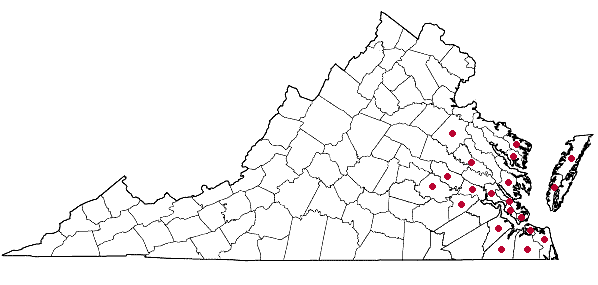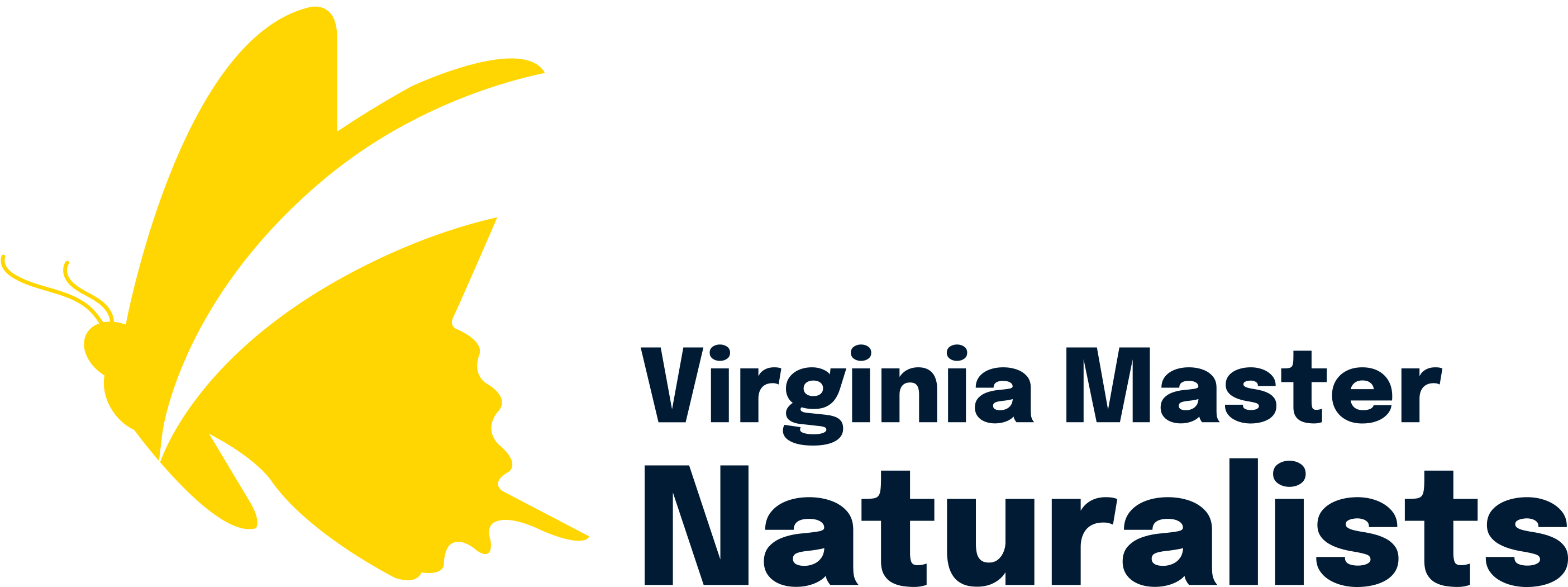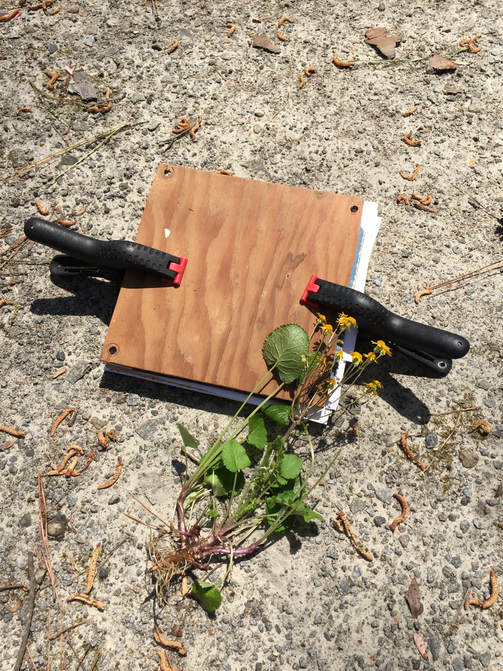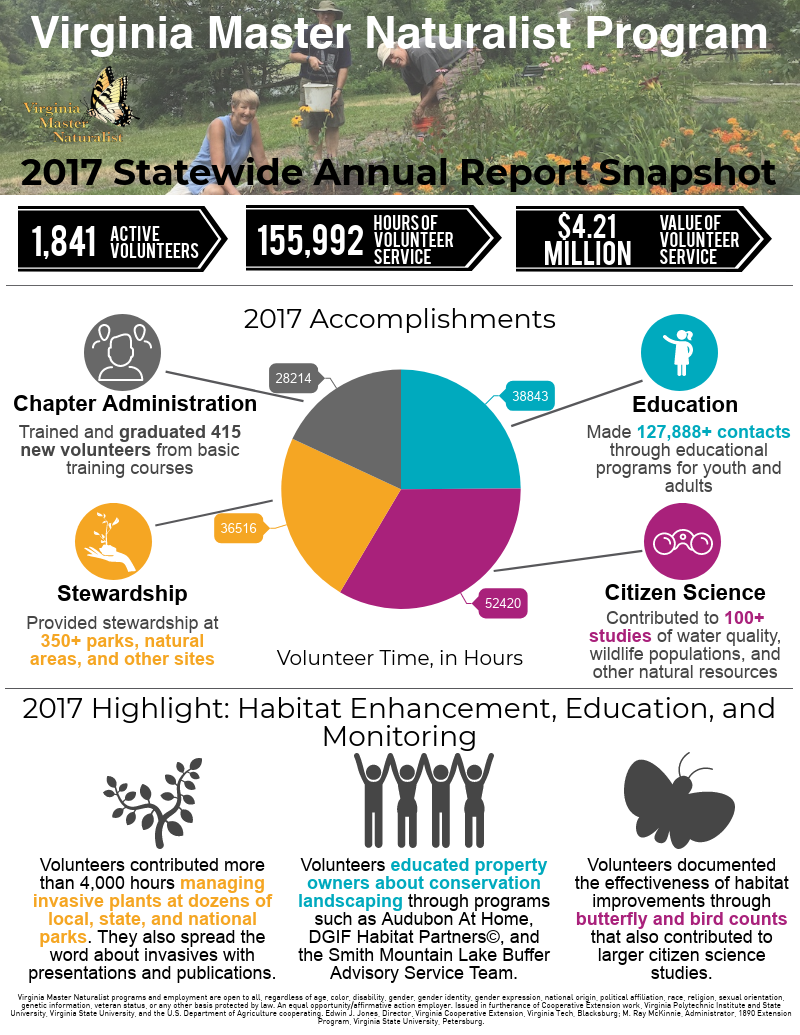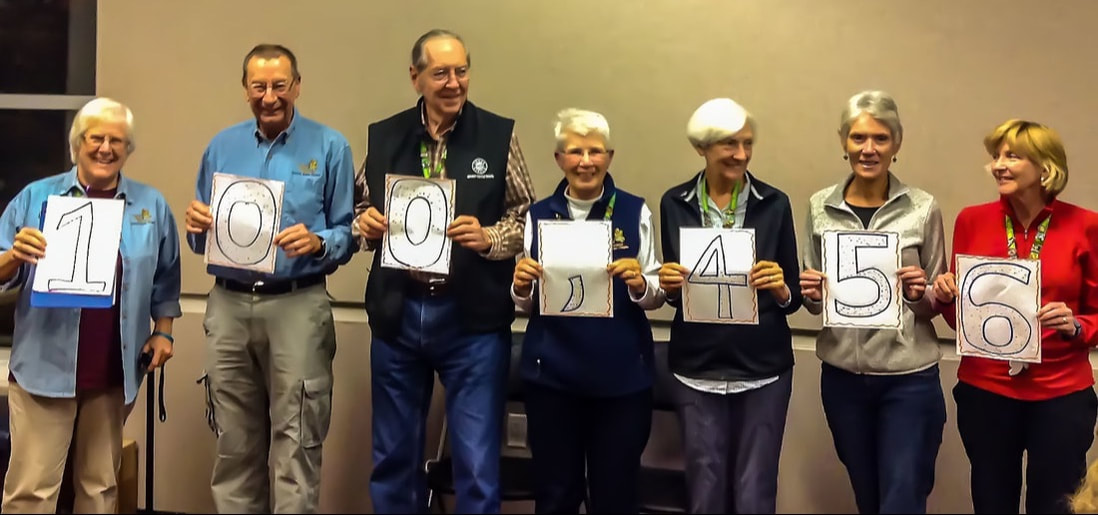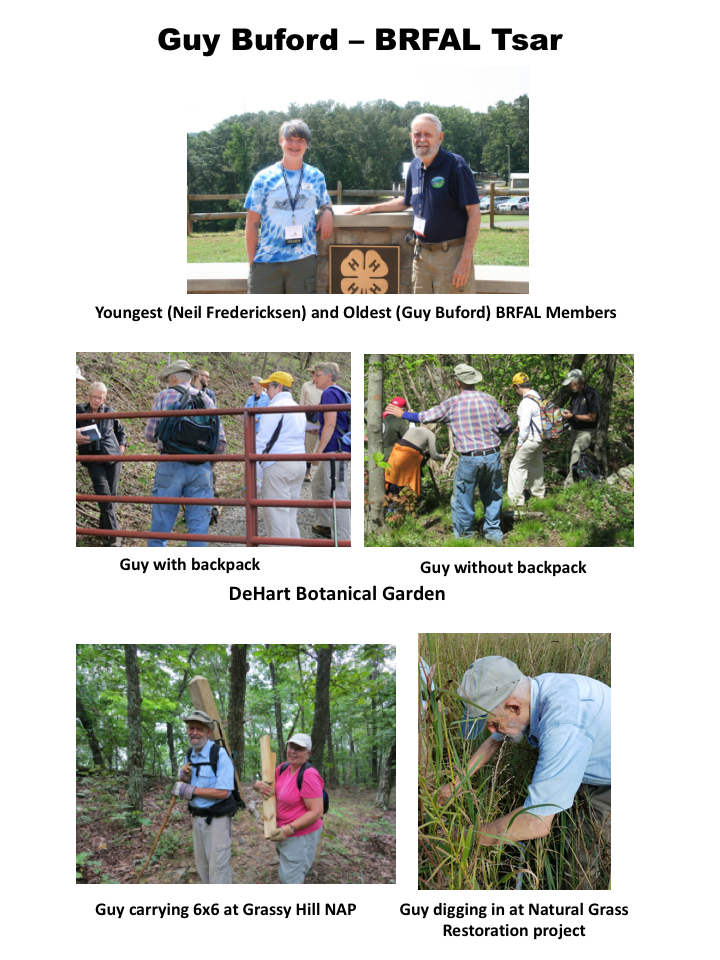Each season, we recognize VMN achievements in the Laurels section of our newsletter. This time, there are LOTS of achievements to note. They are not in any particular order, so please read them all…you never know which volunteer/project/award is going to inspire you!
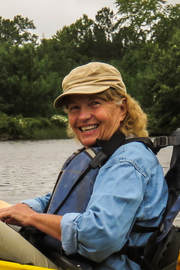 Cheryl Jacobson, VMN-Historic Rivers Chapter
Cheryl Jacobson, VMN-Historic Rivers Chapter
Four More VMNs Reach 5,000 Hours
Only a handful of Virginia Master Naturalist volunteers have reached the milestone of 5,000 hours of service. To get a sense for just how much service that is, keep in mind that a full-time (40 hours per week) job is about 2,080 hours per year. Reaching 5,000 hours of service is like putting in more than 2 years’ worth of full-time work! Congratulations to Cheryl, Jack, Jim, and John for their recent achievements of this milestone. They join Susan Powell (VMN-Historic Rivers Chapter), Marion Childress (VMN-Tidewater Chapter), and Thomas Adkins (former VMN-Shenandoah Chapter member) in that select 5,000 hour group!
From Judy Jones, President of the VMN-Historic Rivers Chapter
In only six years, Cheryl Jacobson of the Historic Rivers Chapter has reached the
5000-hour milestone and our chapter couldn’t be more proud or pleased. Cheryl has given so much to us and our community through her efforts and has been a wonderful representative of Historic Rivers Chapter, serving on the board for four years, on the Basic Training committee for four years, on the board, leading the Osprey Watch project for our Chapter, and working in a myriad of educational, stewardship, and citizen science projects too numerous to list. Well done, Cheryl, and congratulations! We’re so proud of you!
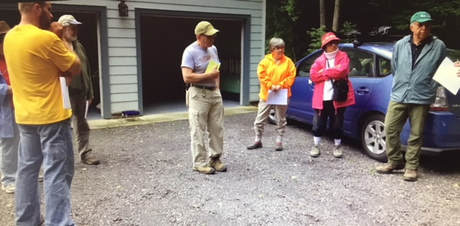 Jack Price (center) leading a class field trip. Photo by Berni Olson.
Jack Price (center) leading a class field trip. Photo by Berni Olson.
From Gail Swift, President of the VMN-Old Rag Chapter
Jack Price, a founding member of Old Rag Master Naturalists, CLASS I, has achieved the incredible award level of 5000 hours, a rarity among VMNs. Jack has devoted so many years of his life to conservation and ORMN, we should not be surprised at this achievement. He volunteers innumerable hours at Shenandoah National Park, helps to develop new projects such as the Yowell Park initiative in Culpeper, and most importantly is very involved as an instructor with ORMN’s training programs. He is well known as a lecturer on native plants and invasives.
From the New River Valley Chapter
We recognized John Ford not too long ago for being the volunteer who completed and reported the most service hours in 2015. That year, he completed and reported 995 hours of Virginia Master Naturalist volunteer service. He has kept up that volunteer energy, and he has now achieved our 5,000 service hour milestone. Among his activities are helping remove invasive plants from Stadium Woods and the Huckleberry Trail in Blacksburg and assisting with chapter administration. But, where he really spends his time was volunteering in the Virginia Tech Herbarium. In fact, he goes in to the Massey Herbarium three mornings a week! Among other projects, he has played a huge role in getting thousands of records added to the specimen database.
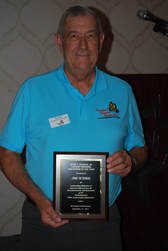 Jim Scibek in 2011, winning a volunteer award from the Fredericksburg Parks and Recreation department.
Jim Scibek in 2011, winning a volunteer award from the Fredericksburg Parks and Recreation department.
From the Central Rappahannock Chapter
Jim Scibek, a long-time member of the VMN-Central Rappahannock Chapter, surpassed 5,000 hours of service in 2017. Jim is an enthusiastic environmental educator and contributes many of his hours getting visitors excited about nature at the Mott’s Run Nature Center in Fredericksburg. He also gives presentations on nature topics to youth groups and at events such Farm Field Days and Earth Day. On top of all that, Jim organizes the chapter’s basic training course and has served as the chapter president for many years.
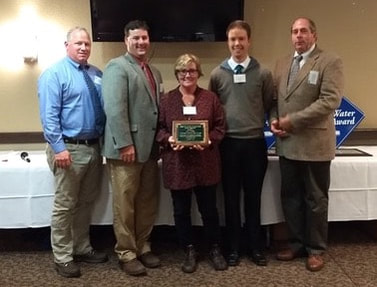 Dana Squire, VMN-Old Rag Chapter, (center) receives the Wildlife Award from the Culpeper Soil and Water Conservation District.
Dana Squire, VMN-Old Rag Chapter, (center) receives the Wildlife Award from the Culpeper Soil and Water Conservation District.
VMN Volunteer Receives Wildlife Award
By Gail Swift, President of the VMN-Old Rag Chapter
The Culpeper Soil & Water Conservation District’s 2017 Wildlife Award was given to Dana Squire of Old Rag Master Naturalists. From 2012 to 2013 Da
na worked with various government agencies to turn her entire backyard – about 4.5 acres – into a wildflower meadow. From bees to butterflies and a great variety of songbirds, truly the wildlife has benefited greatly. Dana has had to commit herself to doing prescribed burning with the Virginia Department of Forestry to keep the meadow in shape and has done invasive species control through the Blue Ridge PRISM project. In addition to Old Rag Master Naturalists, where she oversees the VMN reporting system, is an ex officio member of the board, and volunteers in so many projects such as Old Rag Restoration, Dana is also heavily involved with the Virginia Working Landscapes (VWL) program of the Smithsonian Conservation Biology Institute. Dana was a part of the first cohort of citizen scientists trained and deployed by Smithsonian scientists to conduct biodiversity surveys on private lands throughout the VWL region in 2010. Rather than limiting herself to a single survey type, as many citizen scientists do, Dana has participated in grassland bird, plant and pollinator surveys over her 7-year commitment to the program.
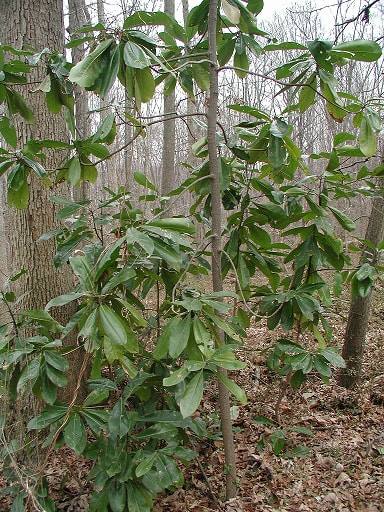 Sweetbay Magnolia (Magnolia virginiana), the signature plant of magnolia bogs. Photo courtesy of Greg Zeil.
Sweetbay Magnolia (Magnolia virginiana), the signature plant of magnolia bogs. Photo courtesy of Greg Zeil.
Arlington Earns Award for Restoring Globally Rare Ecosystem
By Kasha Helget, VMN-Arlington Regional Chapter
In October 2017, the Virginia Recreation and Park Society honored Arlington County’s Magnolia Bog restoration project as the Best New Environmental Sustainability Award in 2016 (https://newsroom.arlingtonva.us/release/arlington-earns-award-for-restoring-globally-rare-ecosystem/). This award recognizes a 5-year restoration plan that began in 2011 and partnered County’s Department of Parks and Recreation staff with volunteer groups, including Arlington Regional Master Naturalists (ARMN), Earth Sangha, Virginia Native Plant Society and others. The 25-acre magnolia bog is located in Barcroft Park in south Arlington and is one of only two-dozen such bogs known in the world and particularly rare and fragile in an urban landscape. The bog gets its name from the sweetbay magnolias (Magnolia virginiana) that grow there.
“This is a real success story for our County,” said Jane Rudolph, director of Parks and Recreation for the County. “The bog is home to wetlands, natural forest and more locally rare plants than any other site in the County. With the help of dedicated volunteers and partners we hope it will be here for generations of Arlingtonians.”
The County staff, ARMN volunteers, and others inventoried the bog’s plants, uprooted invasive plants, built a vernal pool, and planted native plants. They found about a dozen types of plants that grow nowhere else in Arlington. Today, the bog and its surrounding buffer are nearly 90-percent free of invasive plants. Long-lost animals and plants are returning. New colonies of spring peepers, wood frogs, gray fox, yellow-crowned night herons, and little wood satyr butterflies, as well as uncommon plants such as dwarf ginseng, bloodroot, and wood anemone, are expanding their range inside of Barcroft Park. Long-term success will be measured through periodic plant and animal surveys.
The Magnolia Bog Restoration Project was also honored with a 2016 Achievement Award by the Virginia Association of Counties (VACo). VACo described this innovative program “as a model for natural resource management in urban areas by highlighting opportunities to incorporate community groups in environmental stewardship activities.”
http://www.vaco.org/pressreleases/16releases/16programdescription.pdf.
The full story of the magnolia bog project is featured in: https://armn.org/2016/09/22/barcroft-magnolia-bog-restoration-project-receives-2016-achievement-award/.
Superlative Virginia Master Naturalists of the Merrimac Farm Chapter
By Lisa Matthews (VMN-Merrimac Farm Chapter)
The VMN-Merrimac Farm Chapter (based in Prince William County) has been growing and getting more active! They recently recognized many of their volunteers for noteworthy…or, in some cases, notorious…achievements!
- Dale Alling: Friend of the Community Award (Outreach) – In recognition of his willingness to volunteer 237 hours answering questions at the Prince William Park Visitor Center
- Kelly Krechmer: Citizen Science Award – In recognition of 388 hours participating in and developing Citizen Science projects
- Tom Attanaro: Education and Outreach/”Most likely to be seen in your neighborhood or garden” Award – In recognition of his outreach in educating the community through the Master Naturalist Program, Plant NOVA Natives, Prince William County Schools Habitat Program, and Audubon at Home.
- Judy Gallagher: Continuing Education Award – Our most educated member with 130 hours!
- Carol Tretkoff: Calamine Lotion Stewardship Award – In appreciation for spending 72 hours removing non-native plants and risking an itch!
- Buck Arvin: Muddy Boots Stewardship Award – In recognition of his willingness to stand for 25 hours in the mud doing Stream Monitoring
- Charlie Price: Inspiring New Birders Award – In recognition of teaching birding classes at Shenandoah River State Park
- Kimberly Miller: Fattest Backyard Bird Award – In recognition of completing her volunteer hours watching (and feeding) birds for the Cornell Laboratory Project Feeder Watch
- Valerie Huelsman: Life and Limb Award – In recognition of her willingness to risk Lyme Disease for the Public Good on the Tick Project
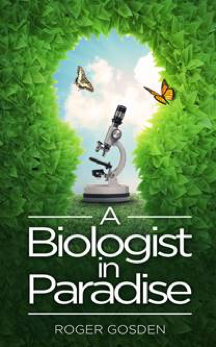
A Biologist in Paradise
By Shirley Devan and Roger Gosden (VMN-Historic Rivers Chapter)
Historic Rivers Chapter Master Naturalist Roger Gosden published “A Biologist in Paradise: Musings on Nature and Science” in December 2017. Roger turned to full time writing after a career in reproductive science and became a Master Naturalist in Williamsburg, VA in 2010. He writes about things he knows and cares about in forty essays and memoirs, touching on the environment, food, culture, curiosity, and sustainability concerns.
Many of the essays are about naturalists and care of the environment. The first essay is titled “The Heart of a Naturalist.” One chapter features Clyde Marsteller’s zoo (with his permission) and two VMN volunteers kindly donated pictures. This is the first of two volumes, so there’s more to come.
Headwaters Chapter Helps Community Market Receive Virginia Green Travel Award
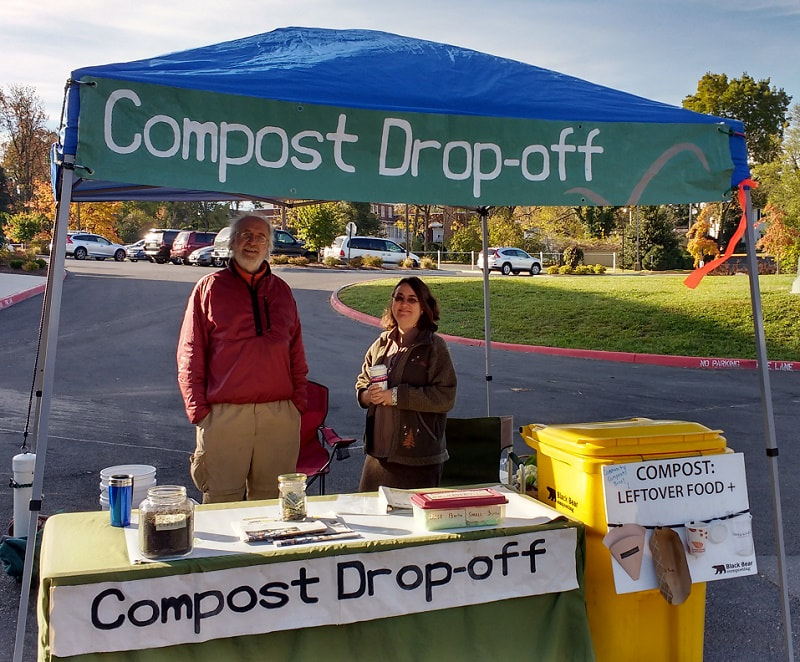 Carl Droms and Kate Guenther (volunteers in the VMN-Headwaters Chapter) staffing the compost drop-off station on its last day of the 2017 season, October 28. Photo by Adrie Voors.
Carl Droms and Kate Guenther (volunteers in the VMN-Headwaters Chapter) staffing the compost drop-off station on its last day of the 2017 season, October 28. Photo by Adrie Voors.
By Adrie Voors, VMN-Headwaters Chapter
The Harrisonburg Farmers Market managers have attributed our Market Compost Drop-off program with their receiving a Virginia Green Travel Award as indicated in the newsletter under “Proudly Green” below, dated December 1, 2017. This project is coordinated by Adrie Voors (VMN-Headwaters Chapter) and Art Fovargue (another dedicated community member), and is a Headwaters Master Naturalists’ project which collaborates with the Climate Action Alliance of the Valley (CAAV), a local small not-for-profit which lets us use their website and treasury. To date, seven Headwaters Chapter members have participated in the project.
Started in March of 2016, we’ve collected an average of 7 tons of household organic waste each of the last two years which would have otherwise ended up in landfills. Our collections are picked up and composted by Black Bear Composting in Crimora. At our weekly Market station each Saturday from April-October, in addition to collecting compostable household organics and Market generated compostable serviceware, we give out compostable bags to collect in, and educate about the wonders of composting and all the ways it benefits our environment. A similar program in Charlottesville that involves some volunteers of the VMN-Rivanna Chapter, was the inspiration for the Harrisonburg program.
Besides CAAV, the Harrisonburg Farmers Market, and Black Bear Composting, other partners include or have included the City of Harrisonburg Public Works, the Harrisonburg Voluntary Gas Tax group, and Keep Virginia Beautiful.
This year we are hoping to sponsor a “zero waste” day at the Market for Earth Day on Saturday, April 21 with compostable serviceware provided to vendors and short zero waste demos.
More here: https://climateactionallianceofthevalley.org/composting/
and here: https://headwatersmn.org/2016/11/03/market-compost-drop-off-project-update/
Roanoke Valley Master Naturalists Investigate Snails and Millipedes
By George Devlin, Chapter Advisor of VMN-Roanoke Valley Chapter
Several Roanoke Chapter VMN members received thanks from the Friends of the Blue Ridge Parkway for their citizen science efforts last summer on the Land Snail and Millipede Transect study which was coordinated by the National Park Service. Land snails are important environmental indicators and predictors of biodiversity, yet they are understudied and poorly understood. Land snails and millipedes also play a major role in the decomposition of leaf litter and other organic matter in forests. Their decaying bodies and feces are a large source of the nitrogen in forest soils and their shells are an important source of calcium that breeding songbirds need for egg production. Many thanks to Bill and Nancy Fabian, David and Lynn Williamson and Laurie and Scott Spangler for collecting and recording survey data from transects along the Blue Ridge Parkway in the Roanoke area.
www.handsontheland.org/environmental-monitoring/land-snails-and-millipedes-transect.html
An Award and an Article from the VMN-Shenandoah Chapter
The VMN-Shenandoah Chapter presented a Volunteer of the Year award to Alex Newhart. The most eloquent nomination, submitted by Laure Wallace, was read to the chapter members.
“This nomination recognizes the selfless and substantial administrative contributions made by Alex Newhart that provide the framework for our chapter’s effective scientific research, stewardship and educational outreach.
Alex joined the Virginia Master Naturalists in 2013 taking his basic training in the Spring of that year. One year later, Alex was running the basic training program, which he has now done for the last 4 years. With full classes each year, Alex has worked tirelessly to incorporate new ideas, focus on the best pedagogy for adult learners, engage exciting new speakers, and tip the balance of training programs towards experiential learning in the field. With yearly rave reviews for the training programs, Alex has been able to attract, train, and certify a growing cadre of new Virginia Master Naturalists, swelling the roster of active volunteers. But for Alex it did not stop there. Alex saw the need for professionalizing the chapter leadership. As president for the last three years, Alex
has created a strategic plan that is redefining the actions and outcomes of chapter committees, focusing on improving the vitality of the chapter and ensuring that our volunteers and volunteer organizations are well served by the leadership of the Shenandoah Chapter. Alex is servant leadership in action.
In 2017 Alex again stepped in to serve not only the Shenandoah Chapter, but the State Offices and all of his colleagues state-wide. Under Alex’s leadership the chapter hosted the 2017 statewide VMN conference. Working with a dynamic committee, Alex worked tirelessly to building a vibrant program of field trips, technical sessions and social activities. His vision and leadership were the foundations of the 2017 conference programs.
While Alex has spent so much of his time leading the chapter, he is also extremely active in a host of other volunteer activities: in vernal pools research, reptile studies, Blandy educational programs, and the Working Landscapes Project, to name just a few. And of course, he shines in these roles as well. While working with the Working Landscapes Project, Alex trapped a Rusty Patched Bumblebee, an endangered bee thought to be extinct in the area. This created quite a buzz in the scientific community and brought attention to the research performed by VMN volunteers. Alex’s scientific contributions and his administrative leadership exemplify what it means to be a Virginia Master Naturalist volunteer in service to our natural resources through science, education and stewardship.
_________________________
An article by Shenandoah Chapter member Margaret Wester, titled “Successful Mixed Species Nesting”, was published in the Virginia Bluebird Society’s Fall 2017 newsletter.
The full article can be found here.
Historic Rivers Master Naturalists Hit the Big 100,000
The Historic Rivers Chapter just passed 100,000 volunteer hours as a group, counting from the founding of the chapter. They logged in approximately 1,000 hours per month in 2017 to reach their goal!
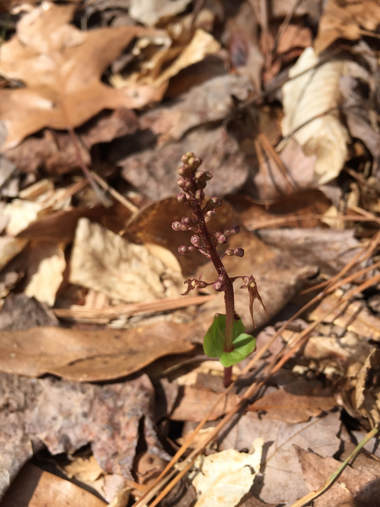 Southern twayblade (Listera australis), a native orchid. Photo by Ashley DeCarme, VMN – Peninsula Chapter
Southern twayblade (Listera australis), a native orchid. Photo by Ashley DeCarme, VMN – Peninsula Chapter 